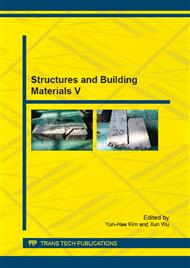p.42
p.48
p.52
p.59
p.64
p.69
p.74
p.85
p.88
Parameter Optimization of Liquid Viscous Damper Based on Energy and Control Indexes under Random Excitation
Abstract:
The damper parameter of a concrete-filled steel tube arch bridge is optimized. Random Fourier spectrum based on physical model is used to synthesis the random time-domain excitation. Four evaluation functions have been constructed as optimization of the objective functions based on energy dissipation and structural control indexes. Comparing two energy evaluation function combinations and traditional control evaluation functions, the damper optimization parameters have been obtained. Result shows that: Optimized damper parameters of concrete-filled steel tubular arch bridge under various seismic waves have high damping effect. After introducing the energy dissipation indexes, evaluation functions avoided the extreme value disadvantages of the traditional target, the final optimization results could be more economical and practical.
Info:
Periodical:
Pages:
64-68
Citation:
Online since:
July 2015
Authors:
Price:
Сopyright:
© 2015 Trans Tech Publications Ltd. All Rights Reserved
Share:
Citation:


